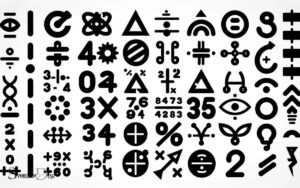Tilde Symbol Meaning in Math: Approximation!
The tilde (~) symbol in mathematics is a versatile character that indicates approximation, similarity, negation, equivalence in set theory, and is commonly used in statistics to denote distributions.
It is an important part of mathematical notation, aiding in the expression of concepts succinctly and accurately.
The tilde symbol is used in various ways within mathematical notation:
Mastering the tilde in math notation unlocks a deeper understanding of approximation, similarity, and probability.

Key Takeaway
Understanding the Tilde (~) Symbol in Mathematics
| Use in Mathematics | Symbol | Meaning | Example |
|---|---|---|---|
| Approximation | ~ | About or approximately | ~100 means approximately 100 |
| Similarity | ~ | Proportional or similar in geometry | Triangle A ~ Triangle B |
| Negation | ~ | Not or the opposite in logic | ~P means not P |
| Equivalence | ~ | Equivalent sets in set theory | A ~ B means set A is equivalent to set B |
| Statistical Distribution | ~ | Has the distribution of | X ~ N(0,1) means X is normally distributed |
Approximation in Mathematical Notation
The tilde symbol ~ is commonly used to denote approximation in mathematical notation. This symbol indicates that the value or expression is close to, but not exactly equal to, the stated value. The tilde is widely recognized as the symbol for approximately in math and appears in various contexts, such as expressing ratios, proportionality, or rounding. For instance, one might write “π ~ 3.14” to signify that the mathematical constant π is approximately equal to 3.14. Its usage helps convey an essential level of precision without implying exact equivalence.
For example, if we write 3.14 ~ π, it signifies that 3.14 is an approximation of the mathematical constant π. In equations, the tilde is utilized to convey that the values are nearly equal, but not precisely.
It is particularly useful when dealing with measurements, significant figures, and rounding off numbers. The tilde allows mathematicians and scientists to express the closeness of a value without implying equality.
Understanding the significance of the tilde in mathematical notation is fundamental for precise and accurate representation of values in various mathematical and scientific disciplines.
Tilde Symbol for Similarity
One common usage of the tilde symbol in mathematics is to denote similarity between geometric figures. When two geometric figures are similar, it means that they have the same shape but not necessarily the same size. The tilde symbol (~) is used to express this similarity.
For example, if triangle ABC is similar to triangle DEF, it would be denoted as ΔABC ~ ΔDEF. This indicates that the corresponding angles of the two triangles are congruent, and the ratios of the lengths of their corresponding sides are equal.
| Geometric Figure | Similar Figure |
|---|---|
| Triangle ABC | Triangle DEF |
| Circle O | Circle P |
| Square XYZ | Square UVW |
Tilde as a Denial Operator
The tilde symbol in mathematics serves as a denial operator, indicating logical negation and negating statements. It is used to express the opposite or the negation of a given statement, playing a crucial role in logic and set theory.
Understanding the function of the tilde as a denial operator is essential for its application in mathematical reasoning and problem-solving.
Tilde Negates Statements
Negating statements using the tilde symbol in mathematics is a fundamental concept essential for understanding logical operations.
In mathematics, the tilde symbol (~) is used to denote logical negation, indicating the opposite of a given statement.
For instance, if P represents a statement, then ~P denotes the negation of P. This means that if the original statement is true, its negation is false, and vice versa. In logical operations, the tilde is crucial for forming compound statements and making logical deductions.
Understanding how the tilde negates statements is fundamental for various mathematical applications, including set theory, propositional logic, and predicate logic.
It provides a way to express contradictions and negations, which are essential for rigorous mathematical reasoning and problem-solving.
Denotes Logical Negation
The tilde symbol in mathematics functions as a denial operator, representing logical negation in statements and propositions. When used in this context, the tilde symbol (~) conveys the opposite meaning of a given statement.
Its role as a denial operator is fundamental in various branches of mathematics and logic, including set theory, propositional logic, and predicate logic.
Understanding the significance of the tilde as a denial operator is crucial for grasping the foundations of mathematical reasoning and logical inference.
The tilde symbol as a denial operator:
- It reverses the truth value of a statement.
- It is used to express the negation of a proposition.
- It plays a key role in forming negated statements and logical conditions.
Tilde in Set Theory
In the context of set theory, the tilde symbol is used to denote equivalence or similarity between sets.
When used between two sets A and B, the expression A ~ B signifies that the sets A and B have the same cardinality, meaning there exists a bijection (a one-to-one correspondence) between the elements of A and B.
This notation emphasizes the notion that the sets are equivalent in size, even if the elements themselves are different. In other words, the tilde symbol in set theory indicates that two sets possess a similar quantity of elements, regardless of their specific contents.
Understanding this concept is fundamental for various applications within mathematics and beyond.
Statistical Usage of the Tilde Symbol
Statistical analysis often employs the tilde symbol to denote the relationship between variables or parameters.
In this context, the tilde symbol (~) is utilized in various ways:
- Approximate Equality: In statistical equations, the tilde symbol is used to indicate that two values are approximately equal, rather than exactly equal. For example, X ~ Y denotes that X is approximately equal to Y.
- Model Specification: The tilde symbol is used to specify the relationship between variables in statistical models. For instance, Y ~ X1 + X2 signifies that the variable Y is modeled as a function of X1 and X2.
- Probability Distribution: In statistics, the tilde symbol is used to denote the distribution of a random variable. For instance, X ~ N(0,1) indicates that the random variable X follows a normal distribution with mean 0 and standard deviation 1.
Tilde in Probability and Statistics
Used widely in probability and statistics, the tilde symbol plays a significant role in denoting relationships between variables and probability distributions. In probability, the tilde (~) is often used to represent the relationship between two random variables.
For instance, if X and Y are random variables, X ~ Y denotes that X has the same distribution as Y. In statistics, the tilde is commonly used to denote estimators. For example, if θ is a parameter and Ĥ is an estimator of θ, then Ĥ ~ θ indicates that Ĥ is an estimator of θ.
Additionally, in descriptive statistics, the tilde is used to represent sample estimators. Understanding the various uses of the tilde symbol in probability and statistics is crucial for interpreting mathematical relationships and making statistical inferences.
Conclusion
The tilde symbol holds various meanings in mathematics, including approximation, similarity, denial, set theory, and statistical usage. Its versatility makes it a valuable tool for representing different concepts and operations in the field of mathematics.
Understanding the multiple uses of the tilde symbol can enhance one’s ability to interpret mathematical notations and equations, leading to a deeper understanding of mathematical concepts.






